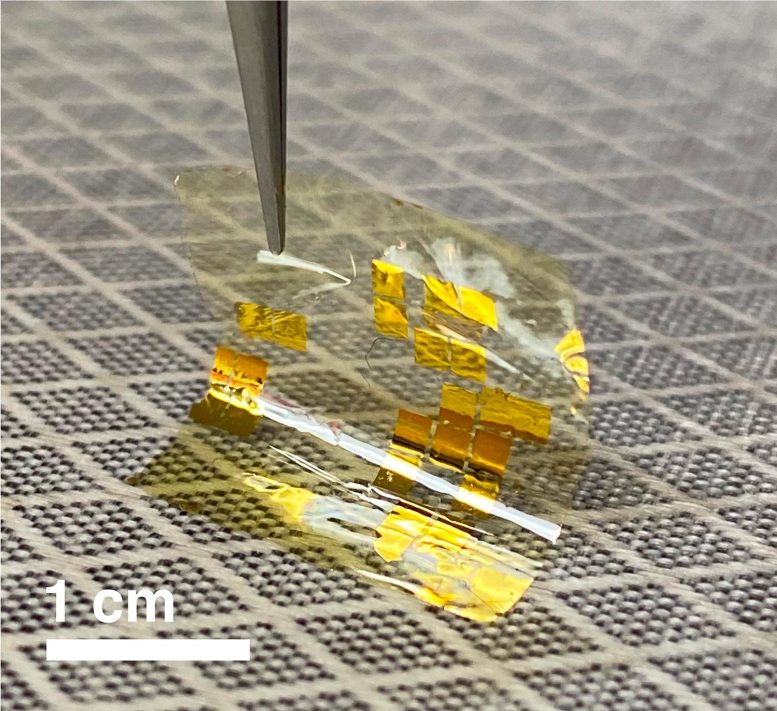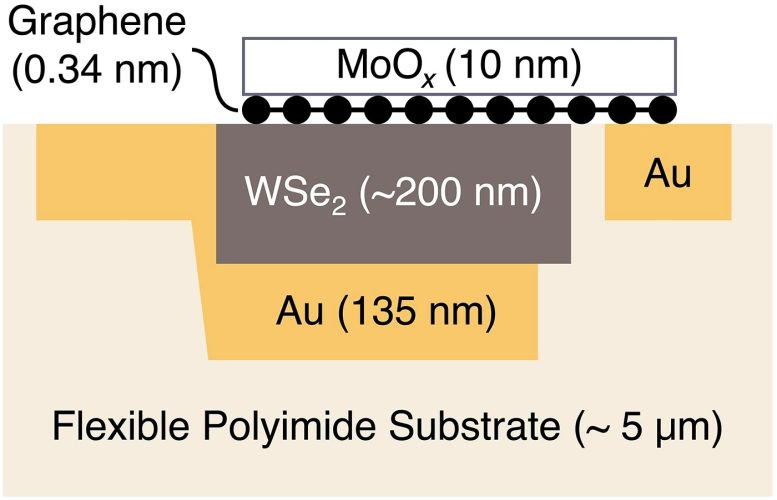
Transition metal dichalcogenide solar cells on a flexible polyimide substrate. Credit: Koosha Nassiri Nazif
New, ultrathin photovoltaic materials could eventually be used in mobile applications, from self-powered wearable devices and sensors to lightweight aircraft and electric vehicles.
A race is on in solar engineering to create almost impossibly-thin, flexible solar panels. Engineers imagine them used in mobile applications, from self-powered wearable devices and sensors to lightweight aircraft and electric vehicles. Against that backdrop, researchers at Stanford University have achieved record efficiencies in a promising group of photovoltaic materials.
Chief among the benefits of these transition metal dichalcogenides – or TMDs – is that they absorb ultrahigh levels of the sunlight that strikes their surface compared to other solar materials.
“Imagine an autonomous drone that powers itself with a solar array atop its wing that is 15 times thinner than a piece of paper,” said Koosha Nassiri Nazif, a doctoral scholar in electrical engineering at Stanford and co-lead author of a study published in the December 9 edition of Nature Communications. “That is the promise of TMDs.”

Cross-section schematic of the device. Credit: Koosha Nassiri Nazif
The search for new materials is necessary because the reigning king of solar materials, silicon, is much too heavy, bulky, and rigid for applications where flexibility, lightweight and high power are preeminent, such as wearable devices and sensors or aerospace and electric vehicles.
“Silicon makes up 95 percent of the solar market today, but it’s far from perfect. We need new materials that are light, bendable and, frankly, more eco-friendly,” said Krishna Saraswat, a professor of electrical engineering and senior author of the paper.
A competitive alternative
While TMDs hold great promise, research experiments to date have struggled to turn more than 2 percent of the sunlight they absorb into electricity. For silicon solar panels, that number is closing in on 30 percent. To be used widely, TMDs will have to close that gap.
The new Stanford prototype achieves 5.1 percent power conversion efficiency, but the authors project they could practically reach 27 percent efficiency upon optical and electrical optimizations. That figure would be on par with the best solar panels on the market today, silicon included.

Stanford electrical engineering Professor Krishna Saraswat (left) and PhD student Koosha Nassiri Nazif. Credit: Mark Golden
Moreover, the prototype realized a 100-times greater power-to-weight ratio of any TMDs yet developed. That ratio is important for mobile applications, like drones, electric vehicles, and the ability to charge expeditionary equipment on the move. When looking at the specific power – a measure of electrical power output per unit weight of the solar cell – the prototype produced 4.4 watts per gram, a figure competitive with other current-day thin-film solar cells, including other experimental prototypes.
“We think we can increase this crucial ratio another ten times through optimization,” Saraswat said, adding that they estimate the practical limit of their TMD cells to be a remarkable 46 watts per gram.
Additional advantages
Their biggest benefit, however, is their remarkable thinness, which not only minimizes the material usage and cost but also makes TMD solar cells lightweight and flexible and capable of being molded to irregular shapes – a car roof, an airplane wing or the human body. The Stanford team was able to produce an active array that is just a few hundred nanometers thick. The array includes the photovoltaic TMD tungsten diselenide and contacts of gold spanned by a layer of conducting